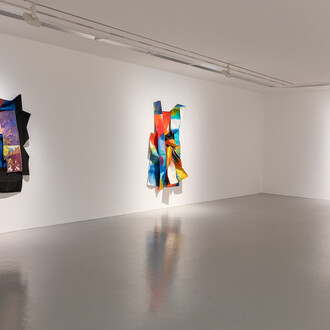Hillsboro Fine Art presents an exhibition of mostly recent paintings by renowned Scottish artist Alan Davie (1920-2014). Davie was a giant of 20th-century art, winning critical acclaim from both critics and fellow artists among them Jackson Pollock, Mark Rothko and David Hockney. Sadly this truly unique voice in painting passed away in early April of this year but his place in history as one of Europe’s most important and influential artists is assured.
Davie’s art making is often described in terms of the shamanistic and spiritual. Like the jazz music he was so fond of, improvisatory gestures, freedom and imagination fuse to form beauty. Ritual, religion and ancient culture all find their place in a magical world of form and colour. These are joyous, celebratory markers along the life journey of this remarkable man. As Helen Little’s essay Alan Davie: Entrance to a Paradise which accompanies the artist’s current display at Tate Britain states "Throughout his career, Davie believed that art should flow out of the totality of life. The content and appearance of his paintings may have changed over the years but, as the works on display at Tate Britain suggest, Davie’s practice was underpinned by his idea that ‘Painting is a continuous process which has no beginning or end. There never really is a point in time when painting is not."
Born in Grangemouth, Scotland, in 1920 Alan Davie studied painting from 1937 to 1941 at the Edinburgh College of Art and also learnt silversmithing. A multi-faceted talent from the start, Davie was interested in exotic art, played several instruments, discovered jazz and joined the Cam Robbie jazz band as a saxophonist. While serving in the Royal Artillery between 1941 and 1946, Davie was inspired by reading James Joyce to write poetry himself.
On his return to London, Alan Davie was particularly taken with the work of Paul Klee and Pablo Picasso exhibited there, which left a lasting impression on him and made him seek contact with modern English painters and their work. Taking Paul Klee's pictorial language as his point of departure, Davie was already working in a manner close to Abstract Expressionism when he linked up with the tradition of early 20th-century Scottish modern art. After his marriage to the artist Janet Gaul, Davie abandoned painting for jazz for a while.
In 1948 Alan Davie met Peggy Guggenheim, who introduced him to early American Abstract Expressionism. Much impressed by the work of Jackson Pollock, Davie returned to painting. 'Music for a Pagan Dance' (1949) is Davie's first public foray into the new abstract 'all-over' style of painting. From then on a semi-automatic method of painting would be characteristic of Davie's approach to his work. Confirmation of Davie's painting came with Peggy Guggenheim's purchase of one of his works.
In 1950 Davie had his first one-man London show, at Gimpel Fils (in 1946 he had already had one at Grant's Bookshop in Edinburgh), where he continued to show regularly. In 1956 Davie went to New York. Primitive art now inspired him to a powerfully gestural approach to painting; in 'Footprint Image' he combined vehement brush strokes with his own footprints. Action Painting became important and Davie sought to contact the conventional painting process by working rapidly on the floor, adding pieces of rubbish, dripping paint and turning pictures around and over.
In the 1960s Davie switched from 'all-over' to compositions of real and fictive signs shaped by contours. Music, to which Davie again began devoting more time in the 1970s, remained a constant during the rest of his life. Considered by many to be one of the most important British artists of the post-war era, his work is distinguished by spontaneity, exuberant colour and improvisation.
One of the few artists from his generation who enjoyed truly international recognition, his work can be seen in galleries and museums worldwide, including Tate Modern, London; The Scottish National Gallery of Modern Art, Edinburgh; the Peggy Guggenheim Collection, Venice; Museum of Modern Art, New York; Stedelijk Museum, Amsterdam; Museu de Arte Contemporanea, São Paulo.



















